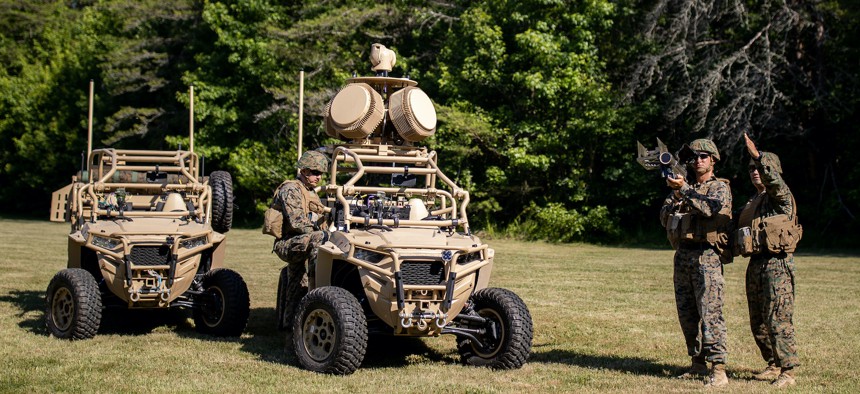
In this 2021 photo, U.S. Marines with the Ground Based Air Defense Program conduct a demonstration of the Light-Marine Air Defense Integrated System (L-MADIS) and FIM-92 Stinger Missile, on Marine Corps Base Quantico, Virginia. U.S. Marine Corps / Tia Dufour
Marine Corps seeks anti-drone tool to defend bases
Call comes amid increased attacks on U.S. assets in the Middle East.
Following numerous drone attacks on U.S. troops in the Middle East, the Marine Corps is searching for a new system to defend its bases from small drones, according to a solicitation released last week.
“An installation security capability gap exists regarding the detection, tracking, identification, and defeat” of small drones near facilities, the solicitation stated.
The solicitation seeks systems that combine anti-drone weapons with methods of taking drones down without destroying them, such as by jamming or capturing them. The system must also be able to detect, track, and identify incoming drones.
Non-kinetic ways of downing drones are important to avoid collateral damage due to falling debris or explosives. Ukraine has used Fortem Technologies DroneHunter F700 drones to protect Ukrainian power stations, for example, which use nets to ensnare Russian drones.
The Marine Corps already operates a mobile anti-drone system called the L-MADIS, which consists of two vehicles armed with jammers and weapons.
The Army and Navy have faced a wave of drone attacks in the Middle East in recent months. While the U.S. military has destroyed most incoming drones, the consequences of even one getting through can be dire.
On Jan. 28, an enemy one-way attack drone hit the barracks on a base in Jordan, killing three soldiers and injuring 40 others. The base did have Coyote drone interceptors, but may have mistakenly identified the enemy drone as friendly.
Still, U.S. methods for destroying such drones can be more expensive than the drones themselves.
While the U.S. did not identify the type of drone used in the Jan. 28 attack, one U.S. defense official called it a type of “Shahed” drone, referring to an Iranian class of one-way attack drones.
A basic Shahed variant, the Shahed-136, can cost as little as $48,800, according to leaked documents from Russian drone producers. The Coyote interceptor, which destroys drones by flying toward them and exploding, costs around $100,0000—double the cost of a Shahed-136.
The cost-to-kill ratio for smaller drones can be even greater, depending on the weapon used to defeat a drone—small first-person-view drones modified with explosives cost as little as $400.
The Marine Corps is not the only service with an increasing focus on countering drones and protecting bases. According to a new Army strategy released this week, that service will add four Indirect Fire Protection Capability base defense battalions, nine counter-drone batteries, and four more Maneuver Short-Range Air Defense battalions.
